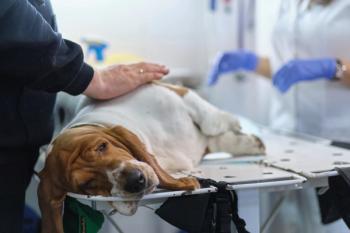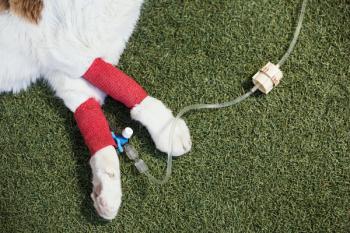
DVMs seeing fewer cases; online survey, long-range government probe continue
Veterinarians are seeing fewer cases related to the nation's ongoing pet-food crisis and hundreds are participating in an online survey they hope finally will solve the mystery of what caused so many pets to become ill and die.
Veterinarians are seeing fewer cases related to the nation's ongoing pet-food crisis and hundreds are participating in an online survey they hope finally will solve the mystery of what caused so many pets to become ill and die.
Survey leader: AAVLD President Dr. Barbara E. Powers reports 430 responses so far in search for cause of pet deaths.
Meanwhile, an inter-agency federal investigation reports progress on several fronts, but some issues still may take months or even years to resolve.
The number of recalled foods stands at more than 100 brands, all listed on government and manufacturer Web sites. Ontario-based Menu Foods, Inc., which launched the first major recall, recently added to its list products that don't contain wheat gluten (one of the tainted ingredients in earlier recalls) but which may have been cross-contaminated at some of its plants.
Veterinarians say the fact that both they and the pet-owning public are more enlightened on the subject has led to more precautions in feeding and ultimately an overall recent decline in the number of pets sickened by tainted food.
The American Veterinary Medical Association (AVMA), which reminds veterinarians and pet owners that "98 percent of pet foods are still deemed safe and haven't been recalled," reports a significant drop in calls from its members seeking advice on the crisis.
The same is true at one of the nation's largest veterinary hospitals, New York City's Animal Medical Center, where Dr. Cathy Langston, head of the Renal Service department, says "We have not been seeing (new) cases in the past month or more. I get a few calls (from veterinarians) about animals that continue to have renal failure; they want to know about long-term management. But there were not as many calls as I would have expected."
Banfield, the Pet Hospital, which offered its extensive database to help the Food and Drug Administration (FDA) monitor the situation from the start, also reports a recent decline in cases.
Dr. Elizabeth Lund, DVM, MPH, PhD, Banfield's senior director of research, tells DVM Newsmagazine, "Those pets we have treated for eating a tainted food are getting better, and the number of pet-food recall cases seen in our practice has diminished quite a bit in the last few weeks."
At press time, Lund offered this short summary: "Banfield can confirm 11 deaths (nine cats and two dogs) associated with the pet-food recall. Our doctors have seen about 2,420 pets (650 cats and 1,770 dogs) suspected of eating a recalled food. Of these pets, most were healthy and had not been affected by the recall."
One question of interest to DVMs concerns the specific cause of pet illnesses and deaths, given that the contaminant melamine, a chemical used in making plastics, is not known to have serious toxic effects in itself.
The AVMA reported in early May that "tests conducted (at the University of Guelph, Ontario) on contaminated pet food and necropsies on affected animals resulted in a new theory that a chemical reaction between melamine and cyanuric acid formed crystals and blocked kidney function" in pets that became ill or died.
It said analysis of crystals in the kidneys of affected animals consisted of about 70 percent cyanuric acid and 30 percent melamine, and that tests mixing the two substances in samples of cat urine "resulted in almost immedicate formation of crystals that were identical to crystals found in the kidneys of affected animals."
But Dr. Barbara E. Powers, professor of surgical pathology at the University of Colorado College of Veterinary Medicine's Department of Microbiology, Immunology and Pathology, tells DVM Newsmagazine that, while renal blockage may play a part, "it's more than that. There's something more going on. Otherwise there wouldn't be so much necrosis (cell death) and inflammation."
Powers, DVM, PhD, Dipl. ACVP, is president of the American Association of Veterinary Laboratory Diagnosticians (AAVLD), which is conducting an online survey of pet-death cases in which recalled food is suspected to play a role. The AVMA encourages its members who specifically treat companion animals and may have seen such cases to participate in the survey. It may be accessed online at
Powers says about 430 veterinarians have submitted cases so far and that more are urged to participate. She says the survey will continue for "another month or so" and then AAVLD members will examine and discuss the findings at their October meeting in Reno, Nev.
"We've had an excellent (survey) response so far," Powers says, but she urges practitioners "to make sure you have very good evidence before submitting a case. We're not just looking for cases of renal failure. That can come from many causes. We need more specific evidence."
Powers explains that, in examining submitted cases, diagnosticians will see "a range of pathology of lesions, depending on how long an animal lived (after ingesting a recalled food), the amount consumed and other factors."
At press time, other key developments in the pet-food crisis included the following:
- Dr. David Acheson, the FDA's assistant commissioner for food protection, told reporters during a May 8 teleconference that contaminated material imported from China and used in pet foods actually was wheat flour, not wheat gluten or rice protein concentrate as had been reported. "We have discovered that the wheat gluten and rice protein were mislabeled,"Acheson said. Melamine might have been added to give the appearance of a higher protein content, he says..
- The FDA and U.S. Department of Agriculture say there is little risk to humans from consuming meat from hogs and chickens that ingested feed supplemented with pet-food scraps containing melamine. The low-risk assessment was based on dilution of contaminants and other factors.
- Acheson told reporters that some of the mislabeled flour was shipped first to Canada and then to the United States as fish meal for commercially raised fish. However, "the levels we are seeing in the fish meal is comparable to that seen in other feed. We have no reason to believe that this is harmful to humans," he said.
- Menu Foods, which so far faces about 50 lawsuits over pet deaths, filed suit through a U.S. affiliate, Menu Foods Midwest Corp., against ChemNutra Inc., of Las Vegas, which it says imported the tainted ingredients from China and supplied them to Menu Foods. The affiliate wants ChemNutra to pay costs associated with the recall, along with punitive damages.
- Menu Foods' Web site lists its out-of-pocket costs from the recall to date at more than $45 million.
- The American Society for the Prevention of Cruelty to Animals (ASPCA) warned that "this crisis is far from over." Dr. Steven Hansen, a toxicologist who manages the ASPCA's Animal Poison Control Center, says in a news release that, "given the fact that there is evidence of cross-contamination in ingredients that may have been considered safe, we need to be much more aware of where the ingredients in our pets' food are coming from."
Newsletter
From exam room tips to practice management insights, get trusted veterinary news delivered straight to your inbox—subscribe to dvm360.





